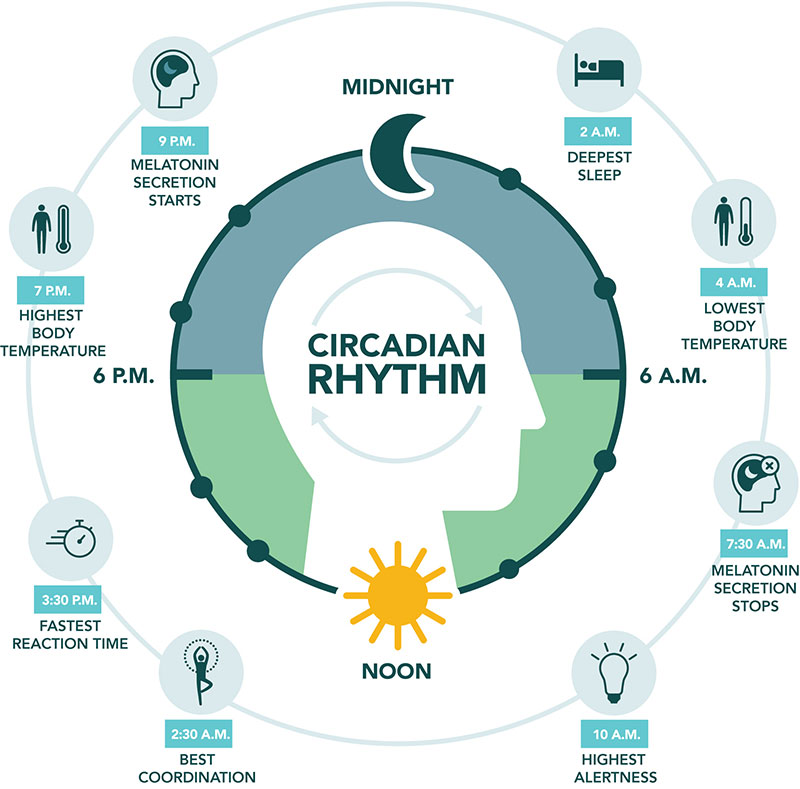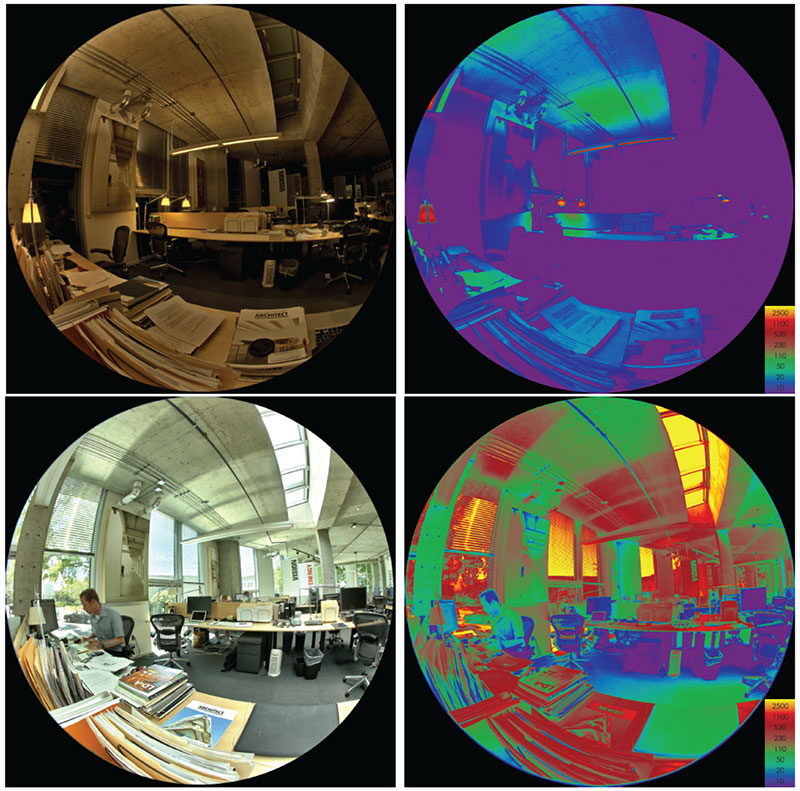Sensors embedded in networked lighting systems can help parcel out the right amount of daylight to building occupants. A look at what could be next on the horizon
By Kevin Van Den Wymelenberg, Alen Mahic and Paul Ward
Humans need daylight. As we have increasingly become an indoor species, society must reckon with the consequential implications this has on our biological processes and natural resources.
For decades, lighting in many of our buildings has not accounted for the physiological rhythms in humans’ sleep-wake cycle, which has negatively impacted our health. Additionally, the energy it takes to provide electric lighting consumes roughly 20% of all electric power generated in the U.S. It’s time to evaluate how healthy indoor spaces may be measured in part by how closely they resemble spaces outside—especially regarding patterns of light and dark.
So, how do we balance the use of technology in buildings with the understanding of humans’ essential connection to the outdoor world? Here is the plot twist: we explore this nature-enmeshed vision for a healthy building future through the lens of a recent technological advancement, namely distributed sensors, and specifically, sensors embedded into networked lighting systems called Luminaire Level Lighting Controls (LLLC).

First, a primer on the evolution of holistic lighting design. Today, the circadian rhythm is no longer a secret (Figure 1). During the day, light exposure prompts the body’s internal clock to send signals that keep the body awake and active. In the evenings, lack of light prompts the body to generate melatonin, the hormone that, for humans, promotes sleep. Timing, duration, intensity, and history of light exposure are all critical factors, but bright light during the day and darkness at night are universally important.
Unfortunately, modern life has evolved to be incongruous with historic circadian rhythms. Presently, humans spend nearly 90% of our time indoors, often without exposure to 24-hour light-dark cycles. We spend days in relatively dim indoor spaces and evenings in similar spaces, now excessively bright compared to the dusk of outdoors. As a result, our sleep-wake cycles can stray by minutes to hours a day. Over time, this can lead to negative consequences regarding alertness, mood and productivity, and can lead to sleep disorders or chronic sleep debt.
Technological advancements and infrastructure development of the early 20th century resulted in abundant and inexpensive electric lighting solutions in spaces without daylight and views, or only very small windows. With the focus on cheap and reliable electric lighting, daylight was considered superfluous, and it was often considered unpredictable and associated with thermal swings and glare.
During the second half of the 20th century, in many spaces, such as classrooms, windows shrunk in size and reduced in number, with their remnants owed to preserving a relic of view or egress rather than functional illumination. In many space types and economic scenarios, windows were excluded entirely from buildings.
As the science and art of holistic lighting design evolved, natural daylighting design made a comeback. In the early 21st century, this was driven by a desire to reduce energy, increase productivity and, to some extent, support health. As the advancement of LED technologies began to erode, the energy efficiency motivation of daylighting, productivity and health priorities were elevated. When it comes to health, a wide range of research suggests a positive directionality between design that incorporates daylight and beneficial health outcomes.
This doesn’t mean we can simply splash abundant daylight (and sunlight) in a building without consequence. If daylight is accompanied with glare and thermal stress or significantly reduces visual or acoustical privacy, then the inclusion of the natural light may erode occupants’ mood and productivity. To avoid repeating history and guard against the possibility of overcorrecting, a balance must be reached between our natural and technical resources.
Luminaire Level Lighting Controls enable innovative solutions to improve indoor environments. LLLC describes lighting systems in which each LED fixture can independently modulate light intensity, apparent color and sometimes even spectral distribution, often through on-board controllers and sensor packages. This typically includes a single multitype sensor for occupancy and daylight harvesting. Because each fixture is capable of sensing and responding to ambient conditions, LLLC systems provide light when and where it is needed, saving significant amounts of energy while maintaining high levels of occupant comfort.
Right now, LLLC occupancy data streams can be leveraged to track and optimize space utilization by giving occupants real-time feedback on space availability via occupancy/vacancy tracking. This is often referred to as “hot desking” or “hoteling” with regard to private and open offices, and the concept applies to other shared spaces like conference rooms and classrooms. LLLC solutions also include asset tracking of moveable equipment, such as audiovisual carts, diagnostic carts and other equipment. In some settings and for some LLLC solutions, wearable devices or smartphones can be integrated to improve awareness of employee work patterns and exposures to various environmental conditions.
In the future, LLLC could be used to track human exposure to daylight and understand the best daylit areas in an office, so more people can have access to it. Essentially, circadian dosing could be implemented through workstation-specific sensing, or via wearables, and programmed to communicate with LLLC systems via Wi-Fi or Bluetooth. Deployed in this way, LLLC solutions help shape circadian cycles by guiding access to daylight as opposed to purporting to modulate electric lighting to do so. Daylight is the circadian dose sledgehammer.

Integrating cameras to access luminance-based data from High Dynamic Range (HDR) imaging could be another facet of the next generation of automated lighting and façade controls. This future development could improve the accuracy of visual glare detection, promote visual comfort, manage automated façades, and optimize circadian dosing for occupants in buildings. Luminance-based data capture and HDR provides pixel-by-pixel resolution of the lighting intensity (Figure 2). Essentially, these sensors can understand more than what our current technology sees in the space around us.
Existing automated lighting controls rely primarily on ceiling-mounted horizontal illuminance sensors, while automated façade controls rely on façade or exterior illuminance or irradiance sensors. These signals are then used as part of a control system that adjusts electric lighting dimming levels to meet a calibrated illuminance set point and close motorized shades or dim dynamic glazing to limit direct sun penetration depth. Conversely, luminance-based sensors focus primarily on the vertical field of view, which is a better representation of how people experience interior spaces compared to illuminance or irradiance sensors. Potentially, cameras in an LLLC solution would not only do a better job controlling lighting but could do a better job integrating with a smart façade with motorized blinds or dynamic glazing—to support human comfort, and yes, increase access to views and the associated brightness for improved circadian dose.
Of course, privacy and security concerns are becoming increasingly relevant. There are justified worries about the proliferation of cameras in the public sphere and while camera-based lighting controls show great potential for predicting occupant visual comfort, they also pose a privacy and security risk. Intentionally low-resolution hardware or encrypted data capture could potentially address these concerns but may introduce additional difficulties as more complex controls systems are needed.
The evidence is clear: lighting in our indoor environments matters. A well daylit space boasts high quality ambience, visual comfort, access to views and substantial circadian exposure, all of which support our health. Indeed, daylight and view are routinely cited as some of the most highly favored amenities among office workers. Additionally, well daylit spaces reduce energy consumption and reduce peak power demand, and a team at MIT has reported statistically significant correlations between higher commercial lease rates and daylight availability.
Current LLLC sensor data streams, as well as those that are still in development or show promise for future development, can help us progress toward buildings that support human health while also saving significant amounts of energy—upwards of 50%. We are in desperate need of design and engineering solutions that have synergies between improved health and energy performance.
Most of the “COVID safe” building solutions—for example, increasing ventilation—increase energy use. In addition to the new emerging challenges of indoor occupancy in the airborne pandemic era, the increased threats that come with our changing climate, such as increased wildfire smoke and outdoor particulates, are also increasing pressure on the role of indoor spaces to support health.
The imperative is that we provide healthy indoor settings while also providing a sustainable energy solution—we posit that braiding LLLC technology with natural systems offers important synergistic solution sets.




